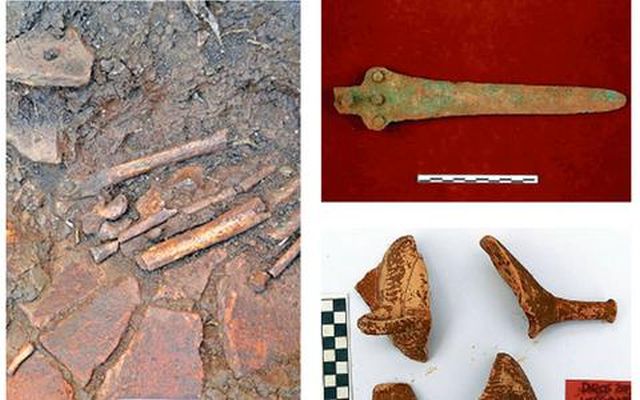A man and woman had been lying underground, embracing each other, for nearly 6,000 years. This very rare double burial was discovered during last year's excavations in the area of Xangounaki, which is located near the Alepotripa cave, Diros, in the Peloponnese.
The announcement of the discovery accidentally coincides with Valentine's Day tomorrow, proving that love is as old as human society.
The funeral of the embraced couple is not the only finding. A second intact funeral of a young man and woman in a particularly bent posture who are tied together with broken arrowheads has been discovered along with it.
The simultaneous double burials are not common, nor are they a common archaeological find. Furthermore, double burials of embracing people are extremely rare, that in Diros being one of the oldest in the world. It was dated back to 3800 BC by radiocarbon, and the DNA analysis of the bones proves that they belonged to a man and woman.
Other finds, such as pottery, beads and tools have been discovered together with the double burials.
Technology
The scientific team performed the analysis using the most advanced equipment to provide convincing answers to its own questions first.
As stated in the bulletin of the Ministry of Culture, an intact burial of a child in a vessel and a burial of an embryo have been discovered in the layers from the late Neolithic, from 4200 to 3800 BC.
The five-year long programme that ended in 2014 was carried out by a scientific team at the Paleoanthropology and Speleology Service of Southern Greece under the guidance of PhD George Papathanasopoulos in cooperation with Greek and foreign scientists.
Another dating and special analyses have significantly expanded the period of use of the cave from the earliest to the late Neolithic period (6000-3200 BC), confirming its continued functioning as a place for living and conducting funerals.
An ossuary with a diameter of 4 metres, which is surrounded by uncut stones and has a floor covered with pebbles has been discovered in the layers of soil too. The large amount of remains of human skeletons of dozens of people has been collected from the floor of the ossuary along with characteristic finds from the Mycenaean Age, including pottery, beads and tools. This facility for secondary burial of dozens of people is unique for the entire Mycenaean Age.

Other finds, such as pottery, beads and tools, have been discovered with the two double burials.
The preliminary research shows that these were secondary burials, i.e. the bones had been transferred to Xangounaki from the place where the deceased had initially been buried. It is noteworthy that no remains of settlements from the Mycenaean Age have been found in the area of the cave despite the systematic research activity.
The nearest settlement of that era is located in Agios Vassilios, at least 40 km away from Alepotripa. The continuing research will help clarify these questions. For now, as stated by the experts who are performing the excavations, we can assume with certainty that, for thousands of years, in the collective memory of the inhabitants of the area, the cave had served as a place where they had buried their dead.
In the past, parts of other burials of adults and children from the Neolithic period were discovered near Xangounaki, who had not been moved elsewhere. The programme "Excavations and research in Diros" aims at recreating the environment of the prehistoric era in western Mani after the Pleistocene and its interaction with the emergence of humans as well as at implementing systematic research in the area of Diros Bay.
History of Alepotripa - accidental discovery and impressive finds
Cave Alepotripa the examination of which began in 1970 by George Papathanasopoulos was inhabited in the Neolithic period (6000-3000 BC) and thousands of artefacts have been discovered in it, including pottery, stone and bone tools, ornaments, and human and animal bones. The most interesting of them are on display in the local museum.
It is located in Diros Bay, 220 metres east of cave Vlychada and about 20 metres above sea level. It was accidentally discovered in 1958 by the Petrohilou family and it is one of the largest and most significant caves in the region of Mani. Alepotripa is a long cave with spacious rooms and numerous corridors with a total length of 280 metres and there is a lake with clean drinking water at the bottom of the largest room.
From Italy to Iran
Although uncommon, the skeletons of other couples, buried embraced, have been discovered during excavations in different parts of the world as well. For 6,000 years, two young lovers have remained hidden from the world, pressed in an eternal embrace. These are "the lovers of Valdaro", a small village near the Italian city of Mantova where two human skeletons embracing and facing each other have been discovered.
Two other embraced skeletons of a man and woman from the Roman era were discovered in Modena in 2006.
Two skeletons of a man and woman kissing were discovered in Hasanaj, Iran, in 1972. They date back to 800 BC, i.e. 2,814 years earlier. It is said that they died together and kissed to show that love is eternal.
Hundreds of skeletons of men and women buried together have been discovered in Siberia too. They are from the Bronze Age, i.e. about 1,500 years old, and some of them are also embraced. Some are holding hands, others simply lie next to one another.
Finally, the skeletons of three members of a family have been discovered in Cyprus. They died embraced, and their death was due to an earthquake.